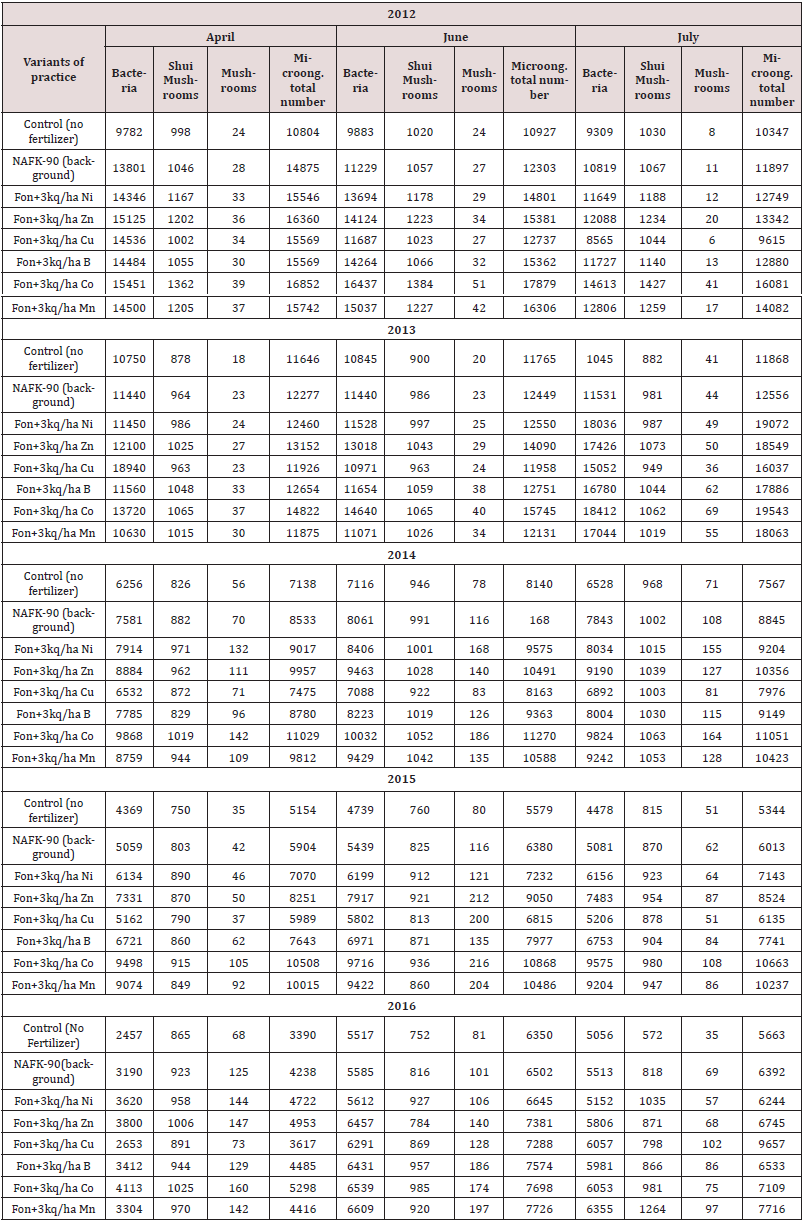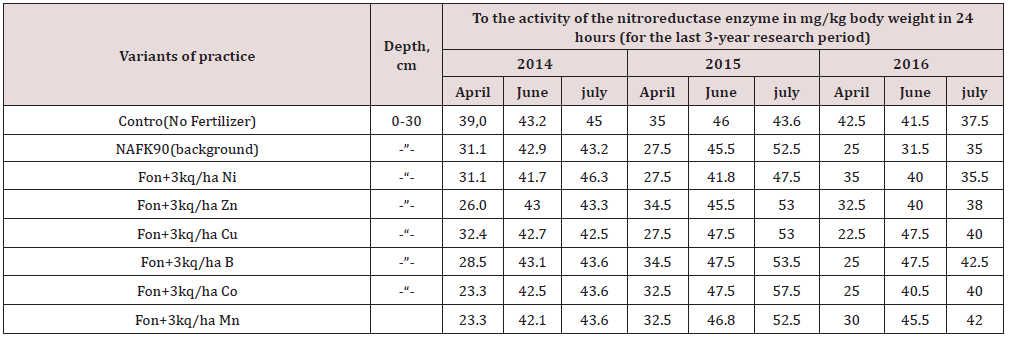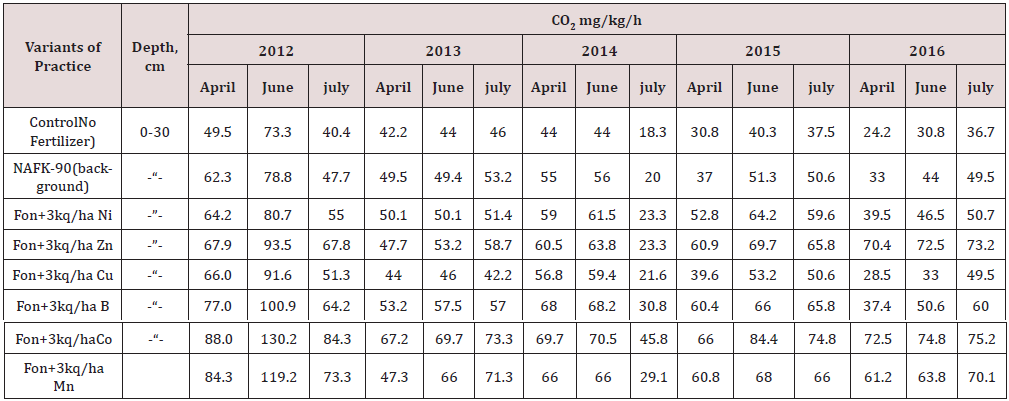
Lupine Publishers Group
Lupine Publishers
Menu
ISSN: 2641-6794
Review Article2641-6794 
The South-Eastern Slope of the Greater Caucasus the Impact of Micromobiements to the Microbiological Process and Fermentative Activity on Territorial Lands Volume 6 - Issue 4
VT Mammadzade*
- Institute of Soil and Agrochemistry of ANAS, Azerbaijan
Received:October 18, 2022 Published: October 28, 2022
Corresponding author:VT Mammadzade, Institute of Soil and Agrochemistry of ANAS, Azerbaija
DOI: 10.32474/OAJESS.2022.06.000242
Abstract
In 2012-2017, the activity of bacteria, ray fungi and microscopic fungi from microorganisms was studied in field experiments with the aim of studying the effect of micronutrients on the productivity of winter wheat in moderately eroded gray mountainbrown soils. The regularity of the activity of the microorganisms that play a major role during the vegetation period of wheat was studied. It was found that the micronutrients given to the soil increased the activity of groups of microorganisms in all variants of the experiment. Thus, the effect of micronutrients on the activity of bacteria was greater. Likewise, micronutrients also increased the activity of fungi and fungi. has increased. The activity of bacteria and fungi has increased. Also, does this group of microorganisms develop better, especially in conditions without humidity? From these 5-6 years of research carried out by us, we can draw the conclusion that microelements significantly revive the microbiological process in eroded soils, as a result of which decomposition and synthesis of decay in the soil is significantly improved, and the process of humus formation is accelerated.
Keywords: Hydrothermic Conditions; Fertilizers; Complex Fertilizers (NAFK-90); Bacteria, Radical Mushrooms and Fungi; Microorganisms; Light; Heat; Food; Cobalt; Zinc and Manganese
Introduction
As it is known, the problem of industrial production in the country is a matter of anger as an important issue, the problem of efficient use of land and food production (Figure 1). The lands of the mountainous area are considered a large source of source in the increase in agricultural products in Azerbaijan. In general, you need to take complex zonal combat measures against erosion to use soil lands in the mountainous areas. This explains that the erosion process is widespread in connection with the proper conduct of economic work in a complex geomorphological environment. For many years, the soil has been washed as a result of the erosion process, productivity deteriorates and the volume of nutrients is reduced sharply and their motivation is very limited. The first turn of the bruises in the falling soils, the total number of microorganisms is a significant amount of 1G. In the variant of the ink fertilizer (NAFK-90) (NAFK-90) (NAFK-90), this increase was 750-4071 thousand. The maximum increase in the number of microorganisms was in the options provided by cobalt, zinc and manganese. Development of microorganisms (bacteria, radical and fungi) is accelerating when hydrotmite conditions are improved in June-July and expand the volume of fertilizers. The total number of microorganisms in the variants in the variants in June increased by 229-4861 thousand. In the variant of the complex fertilizer, the total number of microorganisms in June was 631 to 185 thousand in June. The rapid development is to provide the population with enough food. Due to the demand of the day, as a demand for the development of grain production for the purpose of the current economic crisis, state support is in the center of this area [1].
Reduced, its fraction composition deteriorates and decreases the moving part of agronomically valuable humin acids. Thus, the erosion process has a negative impact on the basic parameters of the humus process in the lands. The erosion process also weakens the intensity of all biochemical, fermentative processes and lands from carbon dioxide (CO2). The erosion process is also very weak in the microbiological process. The soil microfa was a solution to biochemical processes, especially in the regulating human synthesis and mineralization, which regulates these processes. Research has been found in the result of erosion process, waterphysical, agrochemical characteristics and nutrients. As a result, the productivity of agricultural crops decreases. This has a negative impact on the biological productivity of our planet. Taking into account the damage caused by erosion into the blessing of the soil, the application of agro-technical measures increasing ink alarm in the fight against it is a great need. The application of a fertilizer system is very important in these events [2].
In the last 30 years, the republic’s fertilizer employees surrendered in the background of simple, complex mineral fertilizers and the republic in the erosion lands of the republic. Previous savings in this issue In other parts of the Tong Union, sufficient materials were collected. However, the physiological and biochemical bases of mineral fertilizers under the country’s erosion lands were not well studied. This article, presented to the discussion of the readers, was dedicated to the “influence of micronutinals” and its settlement. Here, in the south-eastern part of research facilities, fall wheat, complex mineral fertilizers and complex fertilizers and complex fertilizers in the south-eastern part of autumn wheat are dedicated to the results of physiological research and biochemical grounds [3].
The Impact of Micromelements in the Micromology
Progress and analysis of materials: As can be seen from the desktop figures, in April, the microbiological process (in early April) is not intensively. However, despite this, the microbiological process has increased a variable variant of a certain amount of fertilizer. The use of microelements was more than the activities of microorganisms with the choices of cobalt, manganese and zinc. In this case, this study, the impact of fertilizers in this study, it was possible to see this Table 1. In general, the complex zone management measures should be re-performed and important T erosion in order to effective use Land, Especially Land in Mountainous Areas [3].
Table 1: The impact of microelements to the microbiological process on the ground (0-30 cm, 1g in the soil).

This is Explained by The Fact That the Process of Erosion is Widespread Due To The Proper Management of Economic Activities in A Complex Geomorphological Environment RosionEnough Materials Were Also Collected in Other Regions of the Tong Union. However, The Physiological and Biochemical Bases of Individual Species of Mineral Fertilizers Under Cereals in The Country Were Not Well-Studied. This article, which is presented to the readers’ discussion, is Dedicated to the notxue of “The Impact of Micronutinals in the Micromemiological Process” and ITS Solution. Here, in the Southern-Eastern Part of the Arearch Facilities, in the South-Eastern part of the Back of WHEAT, Complex Mineral Fertilizers and Complex Fertilizers and Complex Fertilizers Are Dedicated to The Study of Physiological and biochemical bases [4].
Micromelements of the impact to the Microbiological Process
Progress and Analysis of Materials: As Can Be Seen from The Figures of The Table, in April, The Microbiological Process (in Early April) is not fully intensively. However, in Spite of This, The Microbiological Process Increased to A Certain Amount Of Fertilizer Verse fully Verangers. The Total Number of Microeliuts in The Field of Practice has increased by 337-4861 thousand in 1G of the Total Number of Microorganisms. In The Variant of The Complex Fertilizer (NAFK-90) in The Fertless Variante (NAFK-90), This Increase WAS 750-4071 Thousand. The maximum increase in the number of microorganisms Was in the Options Provided by Cobalt, Zinc and Manganese. The Development of Microorganisms (Bacteria, Radical and Fungi) is accelerated When Hydro thermic Conditions Are Improved in June-July and Expanding the Scope of Fertilizers. The Total Number of Microelganisms in the Veritts Relative to The Research is Determined in June, increased by 229-4861 Thousand in the Soil. In the Variant of The Complex Fertilizer, The Inrease in The Number of Microorganisms Relative to A Fertile Variant Has Changed Between 631 and 185 thousand in June. The Use of Microelements Was More Than the Activity of Microorganisms with Options Applied to Cobalt, Manganese and Zinc. In This Study, This Study, the impact of Fertilizers in This Study in July, IT WAS Possible to See The Following Table. As can be seen from the analysis of the figures in the table, in July, the total number of microorganisms in 1 g of soil increased by 1582-8675 thousand in the options with micronutrients compared to the option without fertilizer. AS can be seen from the figures in the table, the total number of microorganisms in 1 g of soil increased from 666 to 1550 thousand compared to the version without fertilizer [5].
Effect of Trace Elements on Enzymatic Activity in Eroded Soils
The great importance of the enzymatic processes in the soil is explained by their active participation in biochemical processes and humus formation. He also noted that the formation and transformation of substances in the soil takes place with the direct participation of enzymes. As is known, the activity of enzymes is related to many soils ecological factors. In addition to biotic factors, abiotic factors affect the intensity of the enzymatic process. So, in eroded soils that have lost their fertility, biological and biochemical processes stop, which leads to weakening of the enzymatic process. The effect of trace elements on the enzymatic process was studied in moderately eroded steppe brown soils developed in the territory of the research object. The study was conducted in the experimental field planted under the wheat plant in April, May, June, and July. As can be seen from the figures in Table 2 below, in April, catalase activity was 7.0-13.0 cm3 in 1 minute in the non-fertilized variant, while it was 8.6-17.4 cm3 in the variants with compound fertilizer. The highest activity of catalase was observed in variants given zinc, cobalt, and manganese. According to research years, the activity of catalase in June varied between 5.5-15.3 cm3 in the variant without fertilizer, 8.7-16.0 cm3 in the variant given complex fertilizer, and 9.0-25.4 cm3 in the variants given micronutrients. Thus, compared to the variant without fertilizer, the activity of catalase was 1.1-9.5 cm3 in the variant with complex fertilizer, and 3.1-13.1 cm3 in the variant with trace elements. In general, trace elements significantly increased the activity of catalase, as a result of which the biochemical processes in eroded soils were significantly improved [6].
As it is known, enzymes are secreted by the vital activity of soil microorganisms, the root system of plants and mesofauna, and their role in nature and the biosphere is multifaceted. Enzymes, as biological catalysts, speed up chemical processes in the body a hundred thousand times. Catalase breaks down the hydrogen compounds accumulated in the soil into water and oxygen molecules. Considering all this, it can be shown that the effect of trace elements on the enzymatic process is very important. Table 3 shows the activity of the nitro reductase enzyme. As can be seen from this figure, the activity of nitrate reductase in all variants after fertilization in early spring was lower than the non-fertilization variant. Thus, in the variant without fertilizer, the activity of nitrate reductase was 35.0-39 mg/kg in April, while in the variant with compound fertilizer it was 27.5-31.1 mg/kg. Nitrate reductase activity decreased by 7.5-7.9 mg in the variant with complex fertilizer compared to the variant without fertilizer. In April, the activity of nitrate reductase was 23.3-32.4 mg/kg in 24 hours in the variants applied microelements, which decreased by 2.6-15.7 mg/ kg compared to the variant without fertilizers. Nitrate reductase activity was significantly reduced in variants where zinc, cobalt and manganese were applied. In July, the activity of nitrate reductase increased sharply. Thus, its activity (in 24 hours) is 43.2-42.5 mg/ kg in the variant without fertilizer, 43.2-52.5 mg/kg in the variant with complex fertilizer, and 42.5-57.5 mg in the variant with micronutrients /kg has been [7].
Among microelements zinc, cobalt and copper significantly increased the activity intensity of nitrate reductase. As can be seen from the figures in the table, the effect of micronutrients on the activity of nitrate reductase was not observed in April, and its activity was lower in the experimental variants than in the variant without fertilizer. In this regard, it should be noted that the nitrate reductase enzyme ensures the conversion of nitrates into nitrites in the soil. The effect of trace elements on the activity of urease enzyme was also studied in the last 3-year research period in Arizia. It was determined that trace elements significantly increase the activity of urease. June-July) is higher than in spring (April). Thus, in April, the amount of urease in the version without fertilizer was 0.33-0.69 mg (NH3 in 24 hours) in 1 g of soil, while it was 0.84-1.02 mg in the version with compound fertilizer. Nickel, zinc, and urease activity was higher in variants given cobalt. In July, the activity of urease was 0.68-1.14 mg in the variant without fertilizer, 1.02-1.33 mg in the variant with complex fertilizer, and 0.74-1.98 mg in the variant with micronutrients. The activity of urease was high in June (1.40- 2.09 mg) and July (0.80-2.09 mg). In general, the options providing nickel, zinc and cobalt were effective regardless of hydrothermal conditions [8].
Table 4: Effect of trace elements on the activity of nitroreductase enzyme in eroded soils (0-30 cm layer).

Table 5: The impact of microelemenes to the activity of the ureasa enzyme in the ingredient land (in 0-30 cm)

Currently, as a result of the widespread use of nitrate-containing fertilizers in agriculture, nitrates accumulate in the soil, which has a great role in environmental pollution. Nitrates accumulated in the soil are also collected in agricultural plants and transferred to human and animal bodies and cause various pathological conditions. In such conditions, the nitrate reductase enzyme is of great importance. Nitrate reductase serves human health and nature protection by breaking down nitrates accumulated in the soil as can be seen from the analysis of the figures in the table, in July, the total number of microorganisms in 1 g of soil increased by 1582-8675 thousand in the options with micronutrients compared to the option without fertilizer. As can be seen from the figures in the table, the total number of microorganisms in 1 g of soil increased from 666 to 1550 thousand compared to the version without fertilizer [9-14].
Conclusion
a) Microelements increased the activity of groups of microorganisms in all variants. The effect of microelements on the activity of bacteria was greater.
b) Microelements also increased the activity of ray fungi and fungi. The activity of bacteria and fungi increased. This group of microorganisms develops especially well in conditions without humidity.
c) From the conducted 5-year research, it can be concluded that microelements significantly revive the microbiological process in eroded soils, as a result of which decomposition and synthesis of decay in the soil is significantly improved, and the process of humus formation is accelerated.
References
- Abutalybov МГ (1961) Значение мекролетов в растиеноводство Azerbaijan SSR Gos. Publisher, Baku.
- KA Alekperov (1965) About the influence of erosion on the loss of microelements of the soil of Nakhchivan ASSR in book. Microelements and natural radioactivity Theses of reports of the V All-Union Interuniversity Conference Book 1, Petrozavodsk.
- KA Alekperov, AA Ibragimov, Akimtsev VV (1966) Содержание мекреолетов в еродированных почахах Nakhchivansskoy ASSR в кн. Microelements in agriculture and medicine Theses of reports of the V All-Union Conference, T 1, Ulan-Ude.
- B Aliyev, IN Aliyev, ZH Aliyev (2000) Problems of erosion in Azerbaijan and ways to solve it/Publishing house Ziya-IPC "Nurlan", Baku-, pp 122.
- Akimtsev VV (1993) Content of manganese, cobalt, zinc, molybdenum in North-Priazian and Pre-Caucasian chernozems and their influence on growth, development and yield of corn and sunflower. IV All-Union Conference 1963, Изд-во УАСХН, Kyiv.
- Aliyev DA (1995) Influence of microelements on the development and productivity of wheat in the conditions of Azerbaijan. /Авторереферат нандадитской дерессий, Изд-во Азерб. State University, Baku.
- Berishtein F Ya (1998) About the biological role of manganese. Success of modern biology, t.25. №2.
- Bobko E.N.-K questions about the role of boron in plants. Botanical Journal of the USSR, t26, No. 1, 1971.
- Gyulakhmedov AN (1966) Behavior of microelements in saline soils of Azerbaijan, /В kn.»Microelements in agricultural medicine. Tezisy Dokladov V All-Union conference, T 1, Ulan-Ude.
- Mustafaev Ch M, SulakovaL A (1970) Biological activity of soils of mountainous regions of Azerbaijan. /Information materials on the international biological program on the results of work for 1969. /Izd-vo «Elm», Baku.
- Mishustin EN (1977) Ecologo-geographical variability of soil bacteria. /Izd-vo AN SSSR, M.
- Salamov GB (1961) Origin, characteristics of chernozem soils of the forest-steppe and steppe zones of the Greater Caucasus.
- Salaev ME (1965) Conditions of soil formation and soil cover of Azerbaijan, book Agrochemical characteristics of soils of the USSR and republics of Transcaucasia M.
- Ibragimov A A (1982) On the development of erosion processes in mountain chernozems and measures to combat them. / Журнал Вестник с\х науки. #6 Baku.

Top Editors
-

Mark E Smith
Bio chemistry
University of Texas Medical Branch, USA -

Lawrence A Presley
Department of Criminal Justice
Liberty University, USA -

Thomas W Miller
Department of Psychiatry
University of Kentucky, USA -

Gjumrakch Aliev
Department of Medicine
Gally International Biomedical Research & Consulting LLC, USA -

Christopher Bryant
Department of Urbanisation and Agricultural
Montreal university, USA -

Robert William Frare
Oral & Maxillofacial Pathology
New York University, USA -

Rudolph Modesto Navari
Gastroenterology and Hepatology
University of Alabama, UK -

Andrew Hague
Department of Medicine
Universities of Bradford, UK -

George Gregory Buttigieg
Maltese College of Obstetrics and Gynaecology, Europe -

Chen-Hsiung Yeh
Oncology
Circulogene Theranostics, England -
.png)
Emilio Bucio-Carrillo
Radiation Chemistry
National University of Mexico, USA -
.jpg)
Casey J Grenier
Analytical Chemistry
Wentworth Institute of Technology, USA -
Hany Atalah
Minimally Invasive Surgery
Mercer University school of Medicine, USA -

Abu-Hussein Muhamad
Pediatric Dentistry
University of Athens , Greece

The annual scholar awards from Lupine Publishers honor a selected number Read More...







